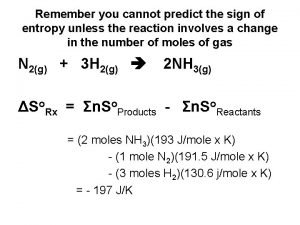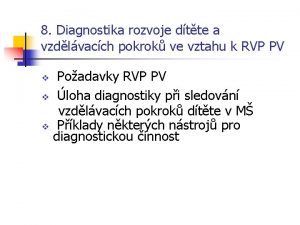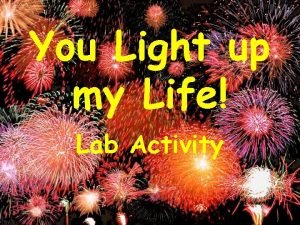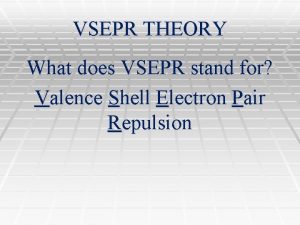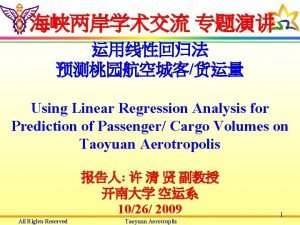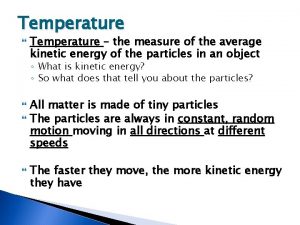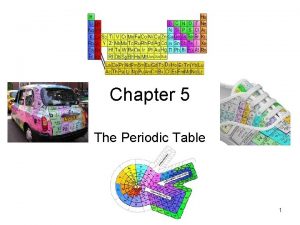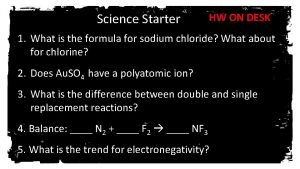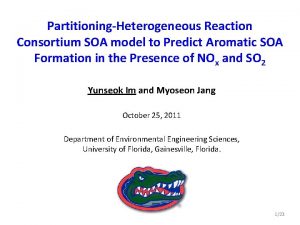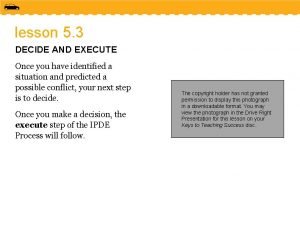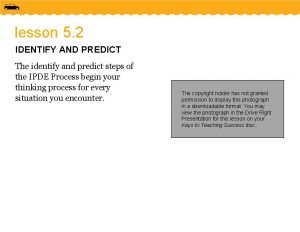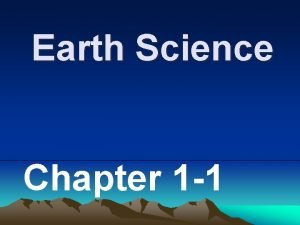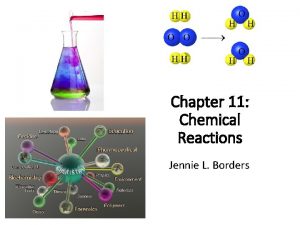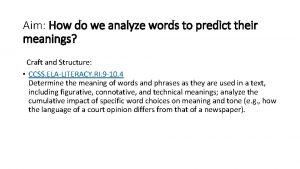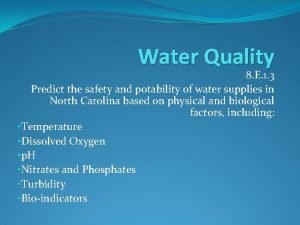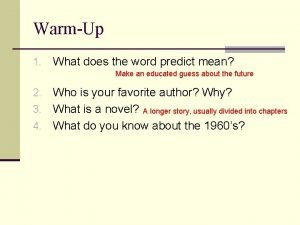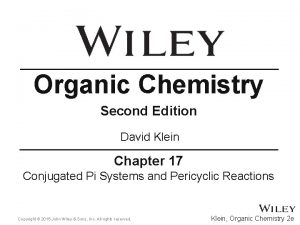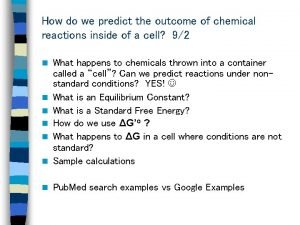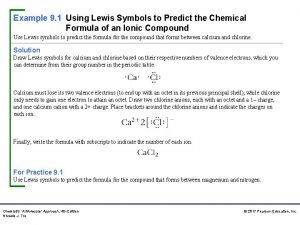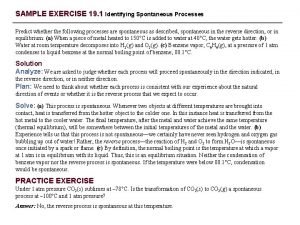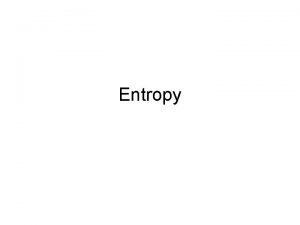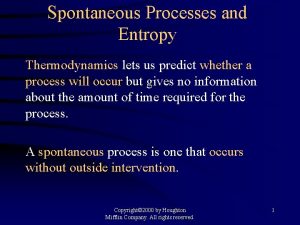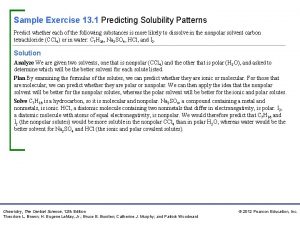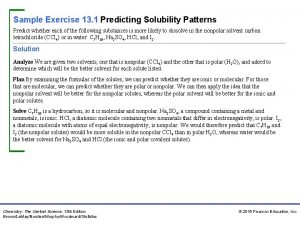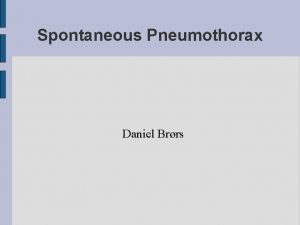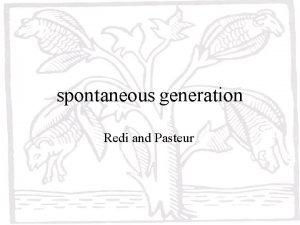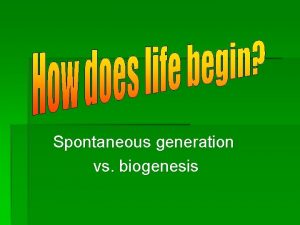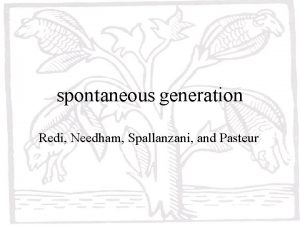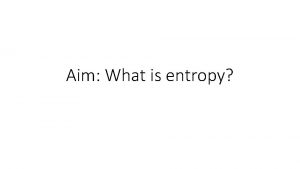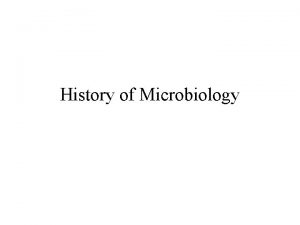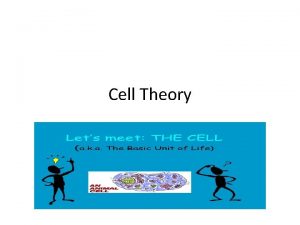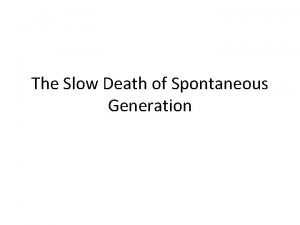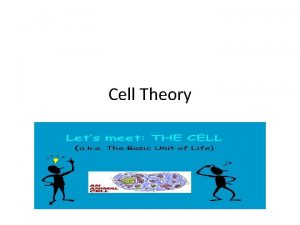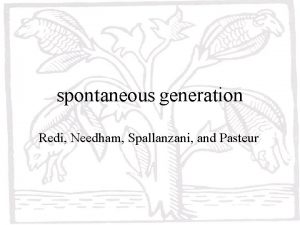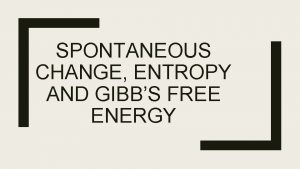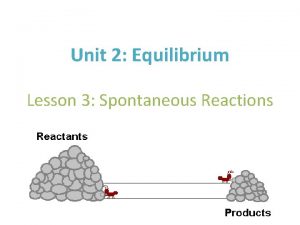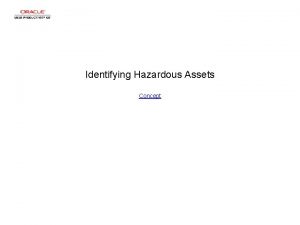Sample Exercise 19 1 Identifying Spontaneous Processes Predict



































- Slides: 35

Sample Exercise 19. 1 Identifying Spontaneous Processes Predict whether each process is spontaneous as described, spontaneous in the reverse direction, or at equilibrium: (a) Water at 40 °C gets hotter when a piece of metal heated to 150 °C is added. (b) Water at room temperature decomposes into H 2(g) and O 2(g). (c) Benzene vapor, C 6 H 6(g), at a pressure of 1 atm condenses to liquid benzene at the normal boiling point of benzene, 80. 1 °C. Solution Analyze We are asked to judge whether each process is spontaneous in the direction indicated, in the reverse direction, or in neither direction. Plan We need to think about whether each process is consistent with our experience about the natural direction of events or whether we expect the reverse process to occur. Solve (a) This process is spontaneous. Whenever two objects at different temperatures are brought into contact, heat is transferred from the hotter object to the colder one. (Section 5. 1) Thus, heat is transferred from the hot metal to the cooler water. The final temperature, after the metal and water achieve the same temperature (thermal equilibrium), will be somewhere between the initial temperatures of the metal and the water. (b) Experience tells us that this process is not spontaneous— we certainly have never seen hydrogen and oxygen gases spontaneously bubbling up out of water! Rather, the reverse process—the reaction of H 2 and O 2 to form H 2 O—is spontaneous. (c) The normal boiling point is the temperature at which a vapor at 1 atm is in equilibrium with its liquid. Thus, this is an equilibrium situation. If the temperature were below 80. 1 °C, condensation would be spontaneous. Chemistry: The Central Science, 13 th Edition Brown/Le. May/Bursten/Murphy/Woodward/Stoltzfus © 2015 Pearson Education, Inc.

Sample Exercise 19. 1 Identifying Spontaneous Processes Continued Practice Exercise 1 The process of iron being oxidized to make iron(III) oxide (rust) is spontaneous. Which of these statements about this process is/are true? (a) The reduction of iron(III) oxide to iron is also spontaneous. (b) Because the process is spontaneous, the oxidation of iron must be fast. (c) The oxidation of iron is endothermic. (d) Equilibrium is achieved in a closed system when the rate of iron oxidation is equal to the rate of iron(III) oxide reduction. (e) The energy of the universe is decreased when iron is oxidized to rust. Practice Exercise 2 At 1 atm pressure, CO 2(s) sublimes at − 78 °C. Is this process spontaneous at − 100 °C and 1 atm pressure? Chemistry: The Central Science, 13 th Edition Brown/Le. May/Bursten/Murphy/Woodward/Stoltzfus © 2015 Pearson Education, Inc.

Sample Exercise 19. 2 Calculating ΔS for a Phase Change Elemental mercury is a silver liquid at room temperature. Its normal freezing point is − 38. 9 °C, and its molar enthalpy of fusion is ΔHfusion = 2. 29 k. J ⁄ mol. What is the entropy change of the system when 50. 0 g of Hg(l) freezes at the normal freezing point? Solution Analyze We first recognize that freezing is an exothermic process, which means heat is transferred from the system to the surroundings and q < 0. Because freezing is the reverse of melting, the enthalpy change that accompanies the freezing of 1 mol of Hg is −ΔHfusion = − 2. 29 k. J / mol. Plan We can use −ΔHfusion and the atomic weight of Hg to calculate q for freezing 50. 0 g of Hg. Then we use this value of q as qrev in Equation 19. 2 to determine ΔS for the system. Solve For q we have Before using Equation 19. 2, we must first convert the given Celsius temperature to kelvins: − 38. 9 °C = (− 38. 9 + 273. 15) K = 234. 3 K Chemistry: The Central Science, 13 th Edition Brown/Le. May/Bursten/Murphy/Woodward/Stoltzfus © 2015 Pearson Education, Inc.

Sample Exercise 19. 2 Calculating ΔS for a Phase Change Continued We can now calculate ΔSsys: Check The entropy change is negative because our qrev value is negative, which it must be because heat flows out of the system in this exothermic process. Comment This procedure can be used to calculate ΔS for other isothermal phase changes, such as the vaporization of a liquid at its boiling point. Practice Exercise 1 Do all exothermic phase changes have a negative value for the entropy change of the system? (a) Yes, because the heat transferred from the system has a negative sign. (b) Yes, because the temperature decreases during the phase transition. (c) No, because the entropy change depends on the sign of the heat transferred to or from the system. (d) No, because the heat transferred to the system has a positive sign. (e) More than one of the previous answers is correct. Chemistry: The Central Science, 13 th Edition Brown/Le. May/Bursten/Murphy/Woodward/Stoltzfus © 2015 Pearson Education, Inc.

Sample Exercise 19. 2 Calculating ΔS for a Phase Change Continued Practice Exercise 2 The normal boiling point of ethanol, C 2 H 5 OH, is 78. 3 °C, and its molar enthalpy of vaporization is 38. 56 k. J ⁄ mol. What is the change in entropy in the system when 68. 3 g of C 2 H 5 OH(g) at 1 atm condenses to liquid at the normal boiling point? Chemistry: The Central Science, 13 th Edition Brown/Le. May/Bursten/Murphy/Woodward/Stoltzfus © 2015 Pearson Education, Inc.

Sample Exercise 19. 3 Predicting the Sign of ΔS Predict whether ∆S is positive or negative for each process, assuming each occurs at constant temperature: (a) H 2 O(l) → H 2 O(g) (b) Ag+(aq) + Cl−(aq) → Ag. Cl(s) (c) 4 Fe(s) + 3 O 2(g) → 2 Fe 2 O 3(s) (d) N 2(g) + O 2(g) → 2 NO(g) Solution Analyze We are given four reactions and asked to predict the sign of ΔS for each. Plan We expect ΔS to be positive if there is an increase in temperature, increase in volume, or increase in number of gas particles. The question states that the temperature is constant, and so we need to concern ourselves only with volume and number of particles. Solve (a) Evaporation involves a large increase in volume as liquid changes to gas. One mole of water (18 g) occupies about 18 m. L as a liquid and if it could exist as a gas at STP it would occupy 22. 4 L. Because the molecules are distributed throughout a much larger volume in the gaseous state, an increase in motional freedom accompanies vaporization and ΔS is positive. (b) In this process, ions, which are free to move throughout the volume of the solution, form a solid, in which they are confined to a smaller volume and restricted to more highly constrained positions. Thus, ΔS is negative. (c) The particles of a solid are confined to specific locations and have fewer ways to move (fewer microstates) than do the molecules of a gas. Because O 2 gas is converted into part of the solid product Fe 2 O 3, ΔS is negative. Chemistry: The Central Science, 13 th Edition Brown/Le. May/Bursten/Murphy/Woodward/Stoltzfus © 2015 Pearson Education, Inc.

Sample Exercise 19. 3 Predicting the Sign of ΔS Continued (d) The number of moles of reactant gases is the same as the number of moles of product gases, and so the entropy change is expected to be small. The sign of ΔS is impossible to predict based on our discussions thus far, but we can predict that ΔS will be close to zero. Practice Exercise 1 Indicate whether each process produces an increase or decrease in the entropy of the system: (a) CO 2(s) → CO 2(g) (b) Ca. O(s) + CO 2(g) → Ca. CO 3(s) (c) HCl(g) + NH 3(g) → NH 4 Cl(s) (d) 2 SO 2(g) + O 2(g) → 2 SO 3(g) Practice Exercise 2 Since the entropy of the universe increases for spontaneous processes, does it mean that the entropy of the universe decreases for nonspontaneous processes? Chemistry: The Central Science, 13 th Edition Brown/Le. May/Bursten/Murphy/Woodward/Stoltzfus © 2015 Pearson Education, Inc.

Sample Exercise 19. 4 Predicting Relative Entropies In each pair, choose the system that has greater entropy and explain your choice: (a) 1 mol of Na. Cl(s) or 1 mol of HCl(g) at 25 °C, (b) 2 mol of HCl(g) or 1 mol of HCl(g) at 25 °C, (c) 1 mol of HCl(g) or 1 mol of Ar(g) at 298 K. Solution Analyze We need to select the system in each pair that has the greater entropy. Plan We examine the state of each system and the complexity of the molecules it contains. Solve (a) HCl(g) has the higher entropy because the particles in gases are more disordered and have more freedom of motion than the particles in solids. (b) When these two systems are at the same pressure, the sample containing 2 mol of HCl has twice the number of molecules as the sample containing 1 mol. Thus, the 2 -mol sample has twice the number of microstates and twice the entropy. (c) The HCl system has the higher entropy because the number of ways in which an HCl molecule can store energy is greater than the number of ways in which an Ar atom can store energy. (Molecules can rotate and vibrate; atoms cannot. ) Practice Exercise 1 Which system has the greatest entropy? (a) 1 mol of H 2(g) at STP, (b) 1 mol of H 2(g) at 100 °C and 0. 5 atm, (c) 1 mol of H 2 O(s) at 0 °C, (d) 1 mol of H 2 O(l) at 25 °C. Chemistry: The Central Science, 13 th Edition Brown/Le. May/Bursten/Murphy/Woodward/Stoltzfus © 2015 Pearson Education, Inc.

Sample Exercise 19. 4 Predicting Relative Entropies Continued Practice Exercise 2 Choose the system with the greater entropy in each case: (a) 1 mol of H 2(g) at STP or 1 mol of SO 2(g) at STP, (b) 1 mol of N 2 O 4(g) at STP or 2 mol of NO 2(g) at STP. Chemistry: The Central Science, 13 th Edition Brown/Le. May/Bursten/Murphy/Woodward/Stoltzfus © 2015 Pearson Education, Inc.

Sample Exercise 19. 5 Calculating ΔS° from Tabulated Entropies Calculate the change in the standard entropy of the system, ∆S°, for the synthesis of ammonia from N 2(g) and H 2(g) at 298 K: N 2(g) + 3 H 2(g) → 2 NH 3(g) Solution Analyze We are asked to calculate the standard entropy change for the synthesis of NH 3(g) from its constituent elements. Plan We can make this calculation using Equation 19. 8 and the standard molar entropy values in Table 19. 1 and Appendix C. Chemistry: The Central Science, 13 th Edition Brown/Le. May/Bursten/Murphy/Woodward/Stoltzfus © 2015 Pearson Education, Inc.

Sample Exercise 19. 5 Calculating ΔS° from Tabulated Entropies Continued Solve Using Equation 19. 8, we have ΔS° = 2 S°(NH 3) – [S°(N 22 + 3 S°(H 2)] Substituting the appropriate S° values from Table 19. 1 yields ΔS° = (2 mol)(192. 5 J/mol-K) − [(1 mol)(191. 5 J/mol-K)(3 mol)(130. 6 J/mol-K)] = − 198. 3 J ⁄ K Check: The value for ΔS° is negative, in agreement with our qualitative prediction based on the decrease in the number of molecules of gas during the reaction. Practice Exercise 1 Using the standard molar entropies in Appendix C, calculate the standard entropy change, ΔS°, for the “water-splitting” reaction at 298 K: 2 H 2 O(l) → 2 H 2(g) + O 2(g) (a) 326. 3 J/K (b) 265. 7 J/K (c) 163. 2 J/K (d) 88. 5 J/K (e) − 326. 3 J/K. Practice Exercise 2 Using the standard molar entropies in Appendix C, calculate the standard entropy change, ΔS°, for the following reaction at 298 K: Al 2 O 3(s) + 3 H 2(g) → 2 Al(s) + 3 H 2 O(g) Chemistry: The Central Science, 13 th Edition Brown/Le. May/Bursten/Murphy/Woodward/Stoltzfus © 2015 Pearson Education, Inc.

Sample Exercise 19. 6 Calculating Free-Energy Change from ΔH, ΔT, and ΔS Calculate the standard free-energy change for the formation of NO(g) from N 2(g) and O 2(g) at 298 K: N 2(g) + O 2(g) → 2 NO(g) given that ∆H° = 180. 7 k. J and ΔS° = 24. 7 J ⁄ K. Is the reaction spontaneous under these conditions? Solution Analyze We are asked to calculate ΔG° for the indicated reaction (given ΔH°, ΔS°, and T) and to predict whether the reaction is spontaneous under standard conditions at 298 K. Plan To calculate ΔG°, we use Equation 19. 12, ΔG° = ΔH° − TΔS°. To determine whether the reaction is spontaneous under standard conditions, we look at the sign of ΔG°. Solve Because ΔG° is positive, the reaction is not spontaneous under standard conditions at 298 K. Comment Notice that we had to convert the units of the TΔS° term to k. J so that they could be added to the ΔH° term, whose units are k. J. Chemistry: The Central Science, 13 th Edition Brown/Le. May/Bursten/Murphy/Woodward/Stoltzfus © 2015 Pearson Education, Inc.

Sample Exercise 19. 6 Calculating Free-Energy Change from ΔH, ΔT, and ΔS Continued Practice Exercise 1 Which of these statements is true? (a) All spontaneous reactions have a negative enthalpy change, (b) All spontaneous reactions have a positive entropy change, (c) All spontaneous reactions have a positive free-energy change, (d) All spontaneous reactions have a negative free-energy change, (e) All spontaneous reactions have a negative entropy change. Practice Exercise 2 Calculate ΔG° for a reaction for which ΔH° = 24. 6 k. J and ∆S° = 132 J ⁄ K at 298 K. Is the reaction spontaneous under these conditions? Chemistry: The Central Science, 13 th Edition Brown/Le. May/Bursten/Murphy/Woodward/Stoltzfus © 2015 Pearson Education, Inc.

Sample Exercise 19. 7 Calculating Standard Free-Energy Change from Free Energies of Formation (a) Use data from Appendix C to calculate the standard free-energy change for the reaction P 4(g) + 6 Cl 2(g) → 4 PCl 3(g) at 298 K. (b) What is ΔG° for the reverse of this reaction? Solution Analyze We are asked to calculate the free-energy change for a reaction and then to determine the free-energy change for the reverse reaction. Plan We look up the free-energy values for the products and reactants and use Equation 19. 14: We multiply the molar quantities by the coefficients in the balanced equation and subtract the total for the reactants from that for the products. Solve (a) Cl 2(g) is in its standard state, so ΔGf° is zero for this reactant. P 4(g), however, is not in its standard state, so ΔGf° is not zero for this reactant. From the balanced equation and values from Appendix C, we have ΔG°rxn = 4 ΔGf°[PCl 3(g)] − ΔGf°[P 4(g)] − 6 ΔGf°[Cl 2(g)] = (4 mol)(− 269. 6 k. J ⁄ mol) – (1 mol)(24. 4 k. J ⁄ mol) – 0 = − 1102. 8 k. J That ΔG° is negative tells us that a mixture of P 4(g), Cl 2(g), and PCl 3(g) at 25 °C, each present at a partial pressure of 1 atm, would react spontaneously in the forward direction to form more PCl 3. Remember, however, that the value of ΔG° tells us nothing about the rate at which the reaction occurs. Chemistry: The Central Science, 13 th Edition Brown/Le. May/Bursten/Murphy/Woodward/Stoltzfus © 2015 Pearson Education, Inc.

Sample Exercise 19. 7 Calculating Standard Free-Energy Change from Free Energies of Formation Continued (b) When we reverse the reaction, we reverse the roles of the reactants and products. Thus, reversing the reaction changes the sign of ΔG in Equation 19. 14, just as reversing the reaction changes the sign of ΔH. (Section 5. 4) Hence, using the result from part (a), we have 4 PCl 3(g) → P 4(g) + 6 Cl 2(g) ΔG° = +1102. 8 k. J Practice Exercise 1 The following chemical equations describe the same chemical reaction. How do the free energies of these two chemical equations compare? (1) 2 H 2 O(l) → 2 H 2(g) + O 2(g) (2) H 2 O(l) → H 2(g) + 1⁄2 O 2(g) (a) ΔG° 1 = ΔG° 2, (b) ΔG° 1 = 2 ΔG° 2, (c) 2ΔG° 1 = ΔG° 2, (d) None of the above. Practice Exercise 2 Use data from Appendix C to calculate ΔG° at 298 K for the combustion of methane: CH 4(g) + 2 O 2(g) → CO 2(g) + 2 H 2 O(g). Chemistry: The Central Science, 13 th Edition Brown/Le. May/Bursten/Murphy/Woodward/Stoltzfus © 2015 Pearson Education, Inc.

Sample Exercise 19. 8 Predicting and Calculating ΔG° In Section 5. 7 we used Hess’s law to calculate ∆H° for the combustion of propane gas at 298 K: C 3 H 8(g) + 5 O 2(g) → 3 CO 2(g) + 4 H 2 O(l) ΔH° = − 2220 k. J (a) Without using data from Appendix C, predict whether ΔG° for this reaction is more negative or less negative than ΔH°. (b) Use data from Appendix C to calculate ΔG° for the reaction at 298 K. Is your prediction from part (a) correct? Solution Analyze In part (a) we must predict the value for ΔG° relative to that for ΔH° on the basis of the balanced equation for the reaction. In part (b) we must calculate the value for ΔG° and compare this value with our qualitative prediction. Plan The free-energy change incorporates both the change in enthalpy and the change in entropy for the reaction (Equation 19. 11), so under standard conditions ΔG° = ΔH° – TΔS° To determine whether ΔG° is more negative or less negative than ΔH°, we need to determine the sign of the term TΔS°. Because T is the absolute temperature, 298 K, it is always a positive number. We can predict the sign of ΔS° by looking at the reaction. Chemistry: The Central Science, 13 th Edition Brown/Le. May/Bursten/Murphy/Woodward/Stoltzfus © 2015 Pearson Education, Inc.

Sample Exercise 19. 8 Predicting and Calculating ΔG° Continued Solve (a) The reactants are six molecules of gas, and the products are three molecules of gas and four molecules of liquid. Thus, the number of molecules of gas has decreased significantly during the reaction. By using the general rules discussed in Section 19. 3, we expect a decrease in the number of gas molecules to lead to a decrease in the entropy of the system—the products have fewer possible microstates than the reactants. We therefore expect ΔS° and TΔS° to be negative. Because we are subtracting TΔS°, which is a negative number, we predict that ΔG° is less negative than ΔH°. (b) Using Equation 19. 14 and values from Appendix C, we have ΔG° = 3 ΔGf°[CO 2(g)] + 4 ΔGf°[H 2 O(l)] − ΔGf°[C 3 H 8(g)] − 5 ΔGf°[O 2(g)] = 3 mol(− 394. 4 k. J ⁄ mol) + 4 mol(− 237. 13 k. J ⁄ mol) − 1 mol(− 23. 47 k. J ⁄ mol) − 5 mol(0 k. J ⁄ mol) = − 2108 k. J Notice that we have been careful to use the value of ΔGf° for H 2 O(l). As in calculating H values, the phases of the reactants and products are important. As we predicted, ΔG° is less negative than ΔH° because of the decrease in entropy during the reaction Chemistry: The Central Science, 13 th Edition Brown/Le. May/Bursten/Murphy/Woodward/Stoltzfus © 2015 Pearson Education, Inc.

Sample Exercise 19. 8 Predicting and Calculating ΔG° Continued Practice Exercise 1 If a reaction is exothermic and its entropy change is positive, which statement is true? (a) The reaction is spontaneous at all temperatures, (b) The reaction is nonspontaneous at all temperatures, (c) The reaction is spontaneous only at higher temperatures, (d) The reaction is spontaneous only at lower temperatures. Practice Exercise 2 For the combustion of propane at 298 K, C 3 H 8(g) + 5 O 2(g) → 3 CO 2(g) + 4 H 2 O(g), do you expect ΔG° to be more negative or less negative than ΔH°? Chemistry: The Central Science, 13 th Edition Brown/Le. May/Bursten/Murphy/Woodward/Stoltzfus © 2015 Pearson Education, Inc.

Sample Exercise 19. 9 Determining the Effect of Temperature on Spontaneity The Haber process for the production of ammonia involves the equilibrium N 2(g) + 3 H 2(g) 2 NH 3(g) Assume that ∆H° and ∆S° for this reaction do not change with temperature. (a) Predict the direction in which ∆G for the reaction changes with increasing temperature. (b) Calculate ∆G at 25 °C and at 500 °C. Solution Analyze In part (a) we are asked to predict the direction in which ΔG changes as temperature increases. In part (b) we need to determine ΔG for the reaction at two temperatures. Plan We can answer part (a) by determining the sign of S for the reaction and then using that information to analyze Equation 19. 12. In part (b) we first calculate ΔH° and ΔS° for the reaction using data in Appendix C and then use Equation 19. 12 to calculate ΔG. Solve (a) The temperature dependence of ΔG comes from the entropy term in Equation 19. 12, ΔG = ΔH − TΔS. We expect ΔS for this reaction to be negative because the number of molecules of gas is smaller in the products. Because ΔS is negative, −TΔS is positive and increases with increasing temperature. As a result, ΔG becomes less negative (or more positive) with increasing temperature. Thus, the driving force for the production of NH 3 becomes smaller with increasing temperature. Chemistry: The Central Science, 13 th Edition Brown/Le. May/Bursten/Murphy/Woodward/Stoltzfus © 2015 Pearson Education, Inc.

Sample Exercise 19. 9 Determining the Effect of Temperature on Spontaneity Continued (b) We calculated H° for this reaction in Sample Exercise 15. 14 and ∆S° in Sample Exercise 19. 5: ∆ H° = – 92. 38 k. J and ∆S° = – 198. 3 J/K. If we assume that these values do not change with temperature, we can calculate ∆G at any temperature by using Equation 19. 12. At T = 25 °C = 298 K, we have Notice that we had to convert the units of −TΔS° to k. J in both calculations so that this term can be added to the ΔH° term, which has units of k. J. Chemistry: The Central Science, 13 th Edition Brown/Le. May/Bursten/Murphy/Woodward/Stoltzfus © 2015 Pearson Education, Inc.

Sample Exercise 19. 9 Determining the Effect of Temperature on Spontaneity Continued Comment Increasing the temperature from 298 K to 773 K changes ΔG from − 33. 3 k. J to +61 k. J. Of course, the result at 773 K assumes that ΔH° and ΔS° do not change with temperature. Although these values do change slightly with temperature, the result at 773 K should be a reasonable approximation. The positive increase in ΔG with increasing T agrees with our prediction in part (a). Our result indicates that in a mixture of N 2(g), H 2(g), and NH 3(g), each present at a partial pressure of 1 atm, the N 2(g) and H 2(g) react spontaneously at 298 K to form more NH 3(g). At 773 K, the positive value of ΔG tells us that the reverse reaction is spontaneous. Thus, when the mixture of these gases, each at a partial pressure of 1 atm, is heated to 773 K, some of the NH 3(g) spontaneously decomposes into N 2(g) and H 2(g). Practice Exercise 1 What is the temperature above which the Haber ammonia process becomes nonspontaneous? (a) 25 °C, (b) 47 °C, (c) 61 °C, (d) 193 °C, (e) 500 °C. Practice Exercise 2 (a) Using standard enthalpies of formation and standard entropies in Appendix C, calculate ΔH° and ΔS° at 298 K for the reaction 2 SO 2(g) + O 2(g) → 2 SO 3(g). (b) Use your values from part (a) to estimate ΔG at 400 K. Chemistry: The Central Science, 13 th Edition Brown/Le. May/Bursten/Murphy/Woodward/Stoltzfus © 2015 Pearson Education, Inc.

Sample Exercise 19. 10 Relating ΔG to a Phase Change at Equilibrium (a) Write the chemical equation that defines the normal boiling point of liquid carbon tetrachloride, CCl 4(l). (b) What is the value of ∆G° for the equilibrium in part (a)? (c) Use data from Appendix C and Equation 19. 12 to estimate the normal boiling point of CCl 4. Solution Analyze (a) We must write a chemical equation that describes the physical equilibrium between liquid and gaseous CCl 4 at the normal boiling point. (b) We must determine the value of ΔG° for CCl 4, in equilibrium with its vapor at the normal boiling point. (c) We must estimate the normal boiling point of CCl 4, based on available thermodynamic data. Plan (a) The chemical equation is the change of state from liquid to gas. For (b), we need to analyze Equation 19. 19 at equilibrium (ΔG = 0), and for (c) we can use Equation 19. 12 to calculate T when ΔG = 0. Solve (a) The normal boiling point is the temperature at which a pure liquid is in equilibrium with its vapor at a pressure of 1 atm: Chemistry: The Central Science, 13 th Edition Brown/Le. May/Bursten/Murphy/Woodward/Stoltzfus © 2015 Pearson Education, Inc.

Sample Exercise 19. 10 Relating ΔG to a Phase Change at Equilibrium Continued (b) At equilibrium, ΔG = 0. In any normal boiling-point equilibrium, both liquid and vapor are in their standard state of pure liquid and vapor at 1 atm (Table 19. 2). Consequently, Q = 1, ln Q = 0, and ΔG = ΔG ° for this process. We conclude that ∆G° = 0 for the equilibrium representing the normal boiling point of any liquid. (We would also find that ∆G° = 0 for the equilibria relevant to normal melting points and normal sublimation points. ) Chemistry: The Central Science, 13 th Edition Brown/Le. May/Bursten/Murphy/Woodward/Stoltzfus © 2015 Pearson Education, Inc.

Sample Exercise 19. 10 Relating ΔG to a Phase Change at Equilibrium Continued (c) Combining Equation 19. 12 with the result from part (b), we see that the equality at the normal boiling point, Tb, of Cl 4(l) (or any other pure liquid) is Solving the equation for Tb, we obtain Strictly speaking, we need the values of ∆H° and ∆S° for the CCl 4(l)/CCl 0(g) equilibrium at the normal boiling point to do this calculation. However, we can estimate the boiling point by using the values of ΔH° and S° for the phases of CCl 4 at 298 K, which we obtain from Appendix C and Equations 5. 31 and 19. 8: ΔG° = H° − Tb ΔS° = 0 Tb = ΔH°/ΔS° ΔH° = (1 mol)(− 106. 7 k. J/mol) – (1 mol)(− 139. 3 k. J/mol) = +32. 6 k. J ΔS° = (1 mol)(309. 4 J/mol-K) – (1 mol)(214. 4 J/mol-K) = +95. 0 J/K As expected, the process is endothermic (ΔH > 0) and produces a gas, thus increasing the entropy (ΔS > 0). Wenow use these values to estimate Tb for CCl 0(l): Note that we have used the conversion factor between joules and kilojoules to make the units of ΔH° and ΔS° match. Check The experimental normal boiling point of CCl 4(l) is 76. 5 °C. The small deviation of our estimate from the experimental value is due to the assumption that ΔH° and ΔS° do not change with temperature. Chemistry: The Central Science, 13 th Edition Brown/Le. May/Bursten/Murphy/Woodward/Stoltzfus © 2015 Pearson Education, Inc.

Sample Exercise 19. 10 Relating ΔG to a Phase Change at Equilibrium Continued Practice Exercise 1 If the normal boiling point of a liquid is 67 °C, and the standard molar entropy change for the boilingprocess is +100 J/K, estimate the standard molar enthalpy change for the boiling process. (a) +6700 J, (b) − 6700 J, (c) +34, 000 J, (d) − 34, 000 J. Practice Exercise 2 Use data in Appendix C to estimate the normal boiling point, in K, for elemental bromine, Br 2(l). (The experimental value is given in Figure 11. 5. ) Chemistry: The Central Science, 13 th Edition Brown/Le. May/Bursten/Murphy/Woodward/Stoltzfus © 2015 Pearson Education, Inc.

Sample Exercise 19. 11 Calculating the Free-Energy Change under Nonstandard Conditions Calculate ΔG at 298 K for a mixture of 1. 0 atm N 2, 3. 0 atm H 2, and 0. 50 atm NH 3 being used in the Haber process: Solution Analyze We are asked to calculate ΔG under nonstandard conditions. Plan We can use Equation 19. 19 to calculate ΔG. Doing so requires that we calculate the value of the reaction quotient Q for the specified partial pressures, for which we use the partial-pressures form of Equation 15. 23: Q = [D]d[E]e/[A]a[B]b. We then use a table of standard free energies of formation to evaluate ΔG°. Solve The partial-pressures form of Equation 15. 23 gives In Sample Exercise 19. 9 we calculated ΔG° = − 33. 3 k. J for this reaction. We will have to change the units of this quantity in applying Equation 19. 19, however. For the units in Equation 19. 19 to work out, we will use k. J/mol as our units for ΔG°, where “per mole” means “per mole of the reaction as written. ” Thus, ΔG° = − 33. 3 k. J/mol implies per 1 mol of N 2, per 3 mol of H 2, and per 2 mol of NH 3. Chemistry: The Central Science, 13 th Edition Brown/Le. May/Bursten/Murphy/Woodward/Stoltzfus © 2015 Pearson Education, Inc.

Sample Exercise 19. 11 Calculating the Free-Energy Change under Nonstandard Conditions Continued We now use Equation 19. 19 to calculate ∆G for these nonstandard conditions: ΔG = ΔG° + RT ln Q = (− 33. 3 k. J/mol) + (8. 314 J/mol-K)(298 K)(1 k. J/1000 J) ln(9. 3 × 10– 3) = (− 33. 3 k. J/mol) + (− 11. 6 k. J/mol) = − 44. 9 k. J/mol Comment We see that ΔG becomes more negative as the pressures of N 2, H 2, and NH 3 are changed from 1. 0 atm (standard conditions, ΔG°) to 1. 0 atm, 3. 0 atm, and 0. 50 atm, respectively. The larger negative value for ΔG indicates a larger “driving force” to produce NH 3. We would make the same prediction based on Le Châtelier’s principle. (Section 15. 7) Relative to standard conditions, we have increased the pressure of a reactant (H 2) and decreased the pressure of the product (NH 3). Le Châtelier’s principle predicts that both changes shift the reaction to the product side, thereby forming more NH 3. Practice Exercise 1 Which of the following statements is true? (a) The larger the Q, the larger the ΔG°. (b) If Q = 0, the system is at equilibrium. (c) If a reaction is spontaneous under standard conditions, it is spontaneous under all conditions. (d) The free-energy change for a reaction is independent of temperature. (e) If Q > 1, ΔG > ΔG°. Chemistry: The Central Science, 13 th Edition Brown/Le. May/Bursten/Murphy/Woodward/Stoltzfus © 2015 Pearson Education, Inc.

Sample Exercise 19. 11 Calculating the Free-Energy Change under Nonstandard Conditions Continued Practice Exercise 2 Calculate ΔG at 298 K for the Haber reaction if the reaction mixture consists of 0. 50 atm N 2, 0. 75 atm H 2, and 2. 0 atm NH 3. Chemistry: The Central Science, 13 th Edition Brown/Le. May/Bursten/Murphy/Woodward/Stoltzfus © 2015 Pearson Education, Inc.

Sample Exercise 19. 12 Calculating an Equilibrium Constant from ΔG° The standard free-energy change for the Haber process at 25 °C was obtained in Sample Exercise 19. 9 for the Haber reaction: N 2(g) + 3 H 2(g) 2 NH 3(g) ∆G° = − 33. 3 k. J/mol = – 33, 300 J/mol Use this value of ∆G° to calculate the equilibrium constant for the process at 25 °C. Solution Analyze We are asked to calculate K for a reaction, given ΔG°. Plan We can use Equation 19. 21 to calculate K. Solve Remembering to use the absolute temperature for T in Equation 19. 21 and the form of R that matches our units, we have K = e−ΔG°/RT = e−(− 33, 300 J ⁄ mol)/(8. 314 J/mol-K)(298 K) = e 13. 4 = 7 × 105 Chemistry: The Central Science, 13 th Edition Brown/Le. May/Bursten/Murphy/Woodward/Stoltzfus © 2015 Pearson Education, Inc.

Sample Exercise 19. 12 Calculating an Equilibrium Constant from ΔG° Continued Comment This is a large equilibrium constant, which indicates that the product, NH 3, is greatly favored in the equilibrium mixture at 25 °C. The equilibrium constants for the Haber reaction at temperatures in the range 300 °C to 600 °C, given in Table 15. 2, are much smaller than the value at 25 °C. Clearly, a low-temperature equilibrium favors the production of ammonia more than a high-temperature one. Nevertheless, the Haber process is carried out at high temperatures because the reaction is extremely slow at room temperature. Remember Thermodynamics can tell us the direction and extent of a reaction but tells us nothing about the rate at which it will occur. If a catalyst were found that would permit the reaction to proceed at a rapid rate at room temperature, high pressures would not be needed to force the equilibrium toward NH 3. Practice Exercise 1 The Ksp for a very insoluble salt is 4. 2 × 10− 47 at 298 K. What is ΔG° for the dissolution of the salt in water? (a) − 265 k. J/mol, (b) − 115 k. J/mol, Chemistry: The Central Science, 13 th Edition Brown/Le. May/Bursten/Murphy/Woodward/Stoltzfus (c) − 2. 61 k. J/mol, (d) +115 k. J/mol, (e) +265 k. J/mol. © 2015 Pearson Education, Inc.

Sample Exercise 19. 12 Calculating an Equilibrium Constant from ΔG° Continued Practice Exercise 2 Use data from Appendix C to calculate ∆G° and K at 298 K for the reaction H 2(g) + Br 2(l) 2 HBr(g). Chemistry: The Central Science, 13 th Edition Brown/Le. May/Bursten/Murphy/Woodward/Stoltzfus © 2015 Pearson Education, Inc.

Sample Integrative Exercise Putting Concepts Together Consider the simple salts Na. Cl(s) and Ag. Cl(s). We will examine the equilibria in which these salts dissolve in water to form aqueous solutions of ions: Na. Cl(s) Ag. Cl(s) Na+(aq) + Cl–(aq) Ag+(aq) + Cl–(aq) (a) Calculate the value of ΔG° at 298 K for each of the preceding reactions. (b) The two values from part (a) are very different. Is this difference primarily due to the enthalpy term or the entropy term of the standard free-energy change? (c) Use the values of ΔG° to calculate the Ksp values for the two salts at 298 K. (d) Sodium chloride is considered a soluble salt, whereas silver chloride is considered insoluble. Are these descriptions consistent with the answers to part (c)? (e) How will ΔG° for the solution process of these salts change with increasing T? What effect should this change have on the solubility of the salts? Solution (a) We will use Equation 19. 14 along with ΔGf° values from Appendix C to calculate the ΔG°soln values for each equilibrium. (As we did in Section 13. 1, we use the subscript “soln” to indicate that these are thermodynamic quantities for the formation of a solution. ) We find Chemistry: The Central Science, 13 th Edition Brown/Le. May/Bursten/Murphy/Woodward/Stoltzfus © 2015 Pearson Education, Inc.

Sample Integrative Exercise Putting Concepts Together Continued (b) We can write ΔG°soln as the sum of an enthalpy term, ΔH°soln, and an entropy term, −TΔS°soln: ΔG°soln = ΔH°soln + (−TΔS°soln). We can calculate the values of ΔH°soln and ΔS°soln by using Equations 5. 31 and 19. 8. We can then calculate −TΔS°soln at T = 298 K. All these calculations are now familiar to us. The results are summarized in the following table: The entropy terms for the solution of the two salts are very similar. That seems sensible because each solution process should lead to a similar increase in randomness as the salt dissolves, forming hydrated ions. (Section 13. 1) In contrast, we see a very large difference in the enthalpy term for the solution of the two salts. The difference in the values of ΔG°soln is dominated by the difference in the values of ΔH°soln. (c) The solubility product, Ksp, is the equilibrium constant for the solution process. we can relate Ksp directly to ΔG°soln by using Equation 19. 21: Chemistry: The Central Science, 13 th Edition Brown/Le. May/Bursten/Murphy/Woodward/Stoltzfus (Section 17. 4) As such, © 2015 Pearson Education, Inc.

Sample Integrative Exercise Putting Concepts Together Continued We can calculate the Ksp values in the same way we applied Equation 19. 21 in Sample Exercise 19. 12. We use the ΔG°soln values we obtained in part (a), remembering to convert them from k. J/mol to J/mol: Na. Cl: Ksp = [Na+(aq)][Cl−(aq)] = e−(− 9100) ⁄ [(8. 314)(298)] = e+3. 7 = 40 Ag. Cl: Ksp = [Ag+(aq)][Cl−(aq)] = e−(+55, 600) ⁄ [(8. 314)(298)] = e− 22. 4 = 1. 9 × 10− 10 The value calculated for the Ksp of Ag. Cl is very close to that listed in Appendix D. (d) A soluble salt is one that dissolves appreciably in water. (Section 4. 2) The Ksp value for Na. Cl is greater than 1, indicating that Na. Cl dissolves to a great extent. The Ksp value for Ag. Cl is very small, indicating that very little dissolves in water. Silver chloride should indeed be considered an insoluble salt. Chemistry: The Central Science, 13 th Edition Brown/Le. May/Bursten/Murphy/Woodward/Stoltzfus © 2015 Pearson Education, Inc.

Sample Integrative Exercise Putting Concepts Together Continued (e) As we expect, the solution process has a positive value of ΔS for both salts (see the table in part b). As such, the entropy term of the free-energy change, −TΔS°soln, is negative. If we assume that ΔH°soln and ΔS°soln do not change much with temperature, then an increase in T will serve to make ΔG°soln more negative. Thus, the driving force for dissolution of the salts will increase with increasing T, and we therefore expect the solubility of the salts to increase with increasing T. In Figure 13. 18 we see that the solubility of Na. Cl (and that of nearly any other salt) increases with increasing temperature. (Section 13. 3) Chemistry: The Central Science, 13 th Edition Brown/Le. May/Bursten/Murphy/Woodward/Stoltzfus © 2015 Pearson Education, Inc.
 Identifying and non identifying adjective clauses
Identifying and non identifying adjective clauses Adjective clause identification
Adjective clause identification Information essential
Information essential Concurrent in os
Concurrent in os Chcch3 lewis structure
Chcch3 lewis structure Predict the sign of the entropy change
Predict the sign of the entropy change Reading vipers summarise
Reading vipers summarise Vipers reading comprehension
Vipers reading comprehension Oregonská metoda
Oregonská metoda You light up my life classifying substances answer key
You light up my life classifying substances answer key Predictogram
Predictogram Apa itu randomisasi
Apa itu randomisasi Predict cyber crime
Predict cyber crime What does vsepr stand for in chemistry
What does vsepr stand for in chemistry Linear regression predict
Linear regression predict Gratifying predict meaning
Gratifying predict meaning Temperature is a measure of the average kinetic energy
Temperature is a measure of the average kinetic energy Chapter 1 hatchet
Chapter 1 hatchet Predict whether cesium forms cs or cs2 ions
Predict whether cesium forms cs or cs2 ions Six active reading strategies
Six active reading strategies Predict the products of the following reactions.
Predict the products of the following reactions. 1pox1
1pox1 Identify predict decide execute
Identify predict decide execute When predicting a point of conflict, you predict
When predicting a point of conflict, you predict Observe and infer
Observe and infer Predict the products of the following reactions.
Predict the products of the following reactions. Cytokinesis is about to happen
Cytokinesis is about to happen Predict word root
Predict word root Macbeth act 1, scene 3
Macbeth act 1, scene 3 Predict the sources of water
Predict the sources of water Ponyboy
Ponyboy Lincoln the best way to predict the future is to create it
Lincoln the best way to predict the future is to create it Predict the product for the following cope rearrangement.
Predict the product for the following cope rearrangement. What did manifest destiny predict?
What did manifest destiny predict? Predict the outcome
Predict the outcome Ocn- resonance structures
Ocn- resonance structures





